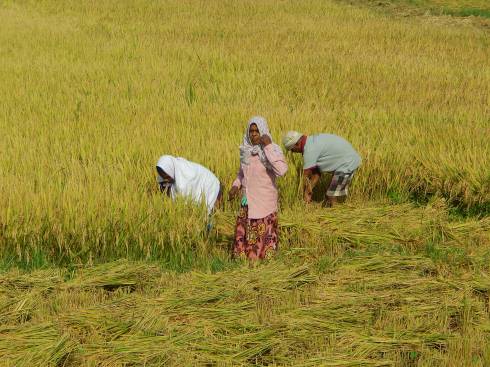Following toast, jam & cakes, we drove for 90 minutes, passing women harvesting rice crops. We stopped briefly for a few of the group to give a small child a packet of sweets. I dropped off the forwarding address for the dentist bill.

First real stop of the day was to the Avukana Ancient Rock Temple – a 12m high Buddha that had been carved from the surrounding rock / cliff. A new modern roof protects the 5th Century sculpture in its jungle setting. Not quite sure why. It is the latest in a long line of roofs. Although we found it interesting, the monkey frog in the pond was also an appeal, not unfortunately listed in the guide books. Yes, a frog that looks like a monkey. It really does. The statue had a huge wasp nest hanging from its right elbow, giving it a somewhat more striking presence.
Moving on, we also had time to find the cotton that comes from the fruit of the capoc tree, eating some small sweet bananas and some typical Sri Lankan “Hawaiian” biscuits (coconut flavour, of course). We had a short walk along the side of a large reservoir – stopping for monkeys and plants that react to your touch by closing up, and then reopening.

We reached the cave temples at the small town of Dambulla and faced some gruelling steps in the heat of the day. The white clad school kids were all looking fresh as we handed over our shoes to a wild haired man and then trudged to the jobsworth entry attendant.

We squeezed into the first of five caves to find a reclining buddha. The second cave contained 57 statues in various poses. One of these included a cobra hooded Buddha, which was supposed to have protected him when meditating in heavy rain. These are ~2100 years old. The third cave had 56 statues, including one of the last king of Sri Lanka. He stood a respectful pace behind the buddha statues, but looked scary. Atmospheric lighting and heavily painted rock ceilings made these caves unmissable. Cave 4 contained an annoying high pitched ant deterrent, so we didn’t linger long time in the smaller caves 4 and 5.
Making friends with more monkeys on the way down, we then headed for a village tour. Jumping on tuk-tuks, we headed off into the jungle. Well, most people did, but there weren’t enough tuk-tuks, so I settled on taking pictures of bullocks, with their owners initials carved into them, until one turned up. The driver asked if I wanted to take the wheel, and I changed into the front seat. As I drive an automatic, lurching was the best this could be described. A clutch was foreign to me, especially on handlebars. The accelerator seemed to go the incorrect way too. But I managed a few bits of straight road before handing back to the driver. Never did get the lesson on where the brakes were.

Joining the rest of the group at the village hut, we were shown a coconut preparation demonstration. Taking the outer layer off, cutting it open with a machete (drinking the juice), and extracting the shredded coconut from the inside with a special hand tool. The two women also demonstrated the grinding of chillies using a large stone. This was then combined with ground onions and lemon juice to make a coconut sambol. This was added to the other lunch ingredients – rice and curry! – which we then had to eat off a banana leaf using only our hands. Much harder than you might imagine. The secret is to get the correct combination of sauce and rice, to form it into balls and throw it at your mouth. Water buffalo curd and honey rounded off the meal – thankfully in plastic bowls with a spoon!
What followed was a masterclass in processing food. Any members of the group who tried to copy, just ended up looking foolish! Firstly it was pounding the raw rice to separate the shell from the rice. This was then wafted in the wind (winnowed) to separate the two. Red millet was ground. This was slightly easier. Lastly, we had a demonstration of leaf / frond weaving. These were used as roofing on the huts.

After this, we headed to the small lake, where what can only be described as tables lashed to 2 canoes were awaiting us. One poor local man tried desperately to point us in the correct direction as we slowly burnt to a crisp on the water, with no escape possible. I was at the front, which meant that the non swimmer was furthest from the supposedly available life jackets.

Deboating, we then headed for the bullock carts awaiting us. Tuk tuks and motorbikes were able to overtake, but cars had a huge problem on the narrow roads. We arrived back and emptied the fridge of the nearby shop of all his cold drinks – which resulted in my drinking Mountain Dew Neon, a high sugar, high caffeine product!
Driving on, we arrived at “The Lake” hotel, Polonnaruwa. This is a 7th century man-made lake. The hotel greeted us with a fresh juice drink and a towel to clean ourselves. Showering was more important than catching the last rays of sun over the lake from the viewing platform around the swimming pool.
The evening meal option was only really in the hotel. A buffet was available – containing the standard rice and curry, but also much more. This didn’t suit some of the group who were after the previously promised a la carte menu.
After a tense stand off, french fries appeared.
Other interesting notes from today – only 85% of Sri Lankan homes have access to electricity. Hoping for 100% by 2025-30.
Also, “How many pecks can a woodpecker peck, if a woodpecker could peck wood?” 20 per second apparently. That’s a possible 11,000 a day.
Bloody annoying though.
Leave a comment